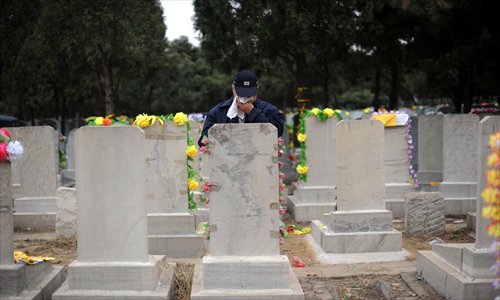Grave purchases

In famed director Feng Xiaogang's 1998 blockbuster Be There Or Be Square, the leading man, Liu Yuan, goes on a date with a sales representative for a cemetery. Instead of romance, Liu, desperate for success in business after multiple failed ventures, ends up buying two burial plots.
Audiences never found out whether Liu's purchase was a wise one, but if the state of affairs in Beijing today is any indication, his purchase was a masterstroke.
Dying to get in
Beijing has become famous for its rapidly increasing housing prices, though if anything, land price increases for the dead have been even more unaffordable.
Statistics show the prices of gravesites in Beijing have been skyrocketing since 2008.
At the Babaoshan People's Cemetery, a well-known graveyard in western Beijing's Shijingshan district, for example, a burial plot was priced at around 100,000 yuan ($16,050) per square meter in late 2012, up more than five-fold from 19,000 yuan in 2008, according to a report in the Beijing-based China Times.
In the same period, property prices only surged twice, with a total increase from 12,102 yuan to 20,286 yuan per square meter, a mere fraction of the increase seen at cemeteries.
By the end of last year, Beijing had 104 cemeteries which were legally registered, 33 of which were private businesses. The remaining graveyards - the public welfare cemeteries - are located in rural areas. They are subsidized by the government and offer free burial plots.
A director surnamed Huang with the funeral management office under Beijing's bureau of civil affairs was quoted by the China Economic Weekly as saying that the public can report public welfare graveyards that illegally charge customers.
However, these free graveyards tend to only supply services to local villagers.
Urban residents, who usually lack other options, can only choose high-priced commercial tombs, which have become even harder to secure.
At Babaoshan, a worker, who declined to be named, said that by the end of last year, there were no available gravesites.
The worker said that the availability of space would depend on the municipal government's planning for land use.
"Even if they become available, fewer than 100 would be given permission to be released," the worker added, "and the public cannot book burial plots either."
In Wan'an Cemetery, another commercial cemetery at the foot of the scenic Fragrant Hills, in northwestern Beijing, sales representatives said that by April last year, all available gravesites had been sold out until the end of 2013.
Workers in Futian Cemetery, another commercial graveyard in the western part of the city, also claimed in a China Times report that no "relatively cheap" burial plots were available, and only those costing at least 236,000 yuan per square meter were left.
Previous news reports said several commercial cemeteries in Beijing have stopped building new gravesites, as the city government has not approved any land for cemeteries, a major factor that some insiders believe has pushed up the price of gravesites.
Life is short, death is shorter
The Ministry of Civil Affairs was quick to dismiss media reports that leased burial plots could only be used for 20 years, clarifying that the maximum leases are 50 to 70 years depending on the condition of the land at the site.
Cemetery management regulations issued in 1992 stipulate that the money paid for a burial plot is only valid for a 20-year period, which means that if the buyer does not pay the tomb maintenance fees after 20 years, the plot will be reclaimed.
This is in contrast to a 70 or 50-year lease enjoyed by a property buyer.
This 20-year payment cycle has been the focus of complaints by many residents, especially those who have chosen not to have children.
"A burial plot costs dozens or even hundreds of thousands of yuan, and is only valid for 20 years," an anonymous interviewee was quoted as saying by the newspaper, adding that the dead may leave a heavy burden for later generations, or die without a burial place.
According to Beijing's civil affairs bureau, ongoing payments are determined by the cemeteries themselves.
In March 2012, the National Development and Reform Commission and the Ministry of Civil Affairs released pricing guidelines on funeral services.
The guideline said that maintenance fees should be charged according to practical operational costs and reasonable profits.
According to a notice by the local price watchdog in Jinan, Shandong Province, burial plots that have surpassed the lease period of 20 years could be charged a monthly fee of up to 25 yuan.
Some insiders point out that without a clear standard, the profits made by the funeral industry remain unclear.
Some reports have claimed that a cemetery with an annual profit of 80 million yuan could cost less than 30 million yuan in terms of investment.
Don't perish in Beijing
"If this crazy surge in prices cannot be contained, the public will be scared away by these exorbitant burial plots," said Wang Zhongwu, a sociologist from the Jinan-based Shandong University.
Wang added that cemeteries are essential public commodities that require additional investment in a bid to ensure they are accessible to the public.
He Bing, the head of the Law School at the China University of Political Science and Law, said "The public only pay for the right to use cemeteries rather than ownership, and they are required to pay maintenance fees after 20 years. In this sense, officials who set prices must assess the fees that will be charged and put the price within a reasonable range."
The set of standards that were outlined 20 years ago aren't suitable for the current management of cemeteries, Yan Xiguang, deputy chairman of the Sociology Society of Shandong Province, said, adding that different cemeteries that serve different needs will require diverse regulations.